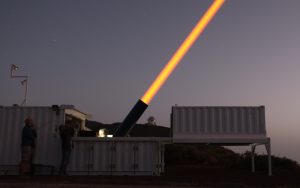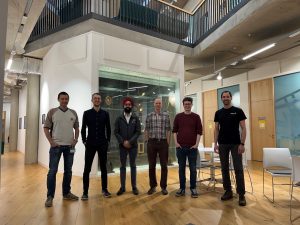The resulting forecasting tool will be used, the organisations say, to optimise Viasat’s ground station design and support operational decision-making such as network switching between ground stations based on atmospheric conditions.
Specifically – for the first phases of the project, using a £200k investment from the US company – the University will focus on developing FSO turbulence channel characterisation for optical feeder links. The research will support delivery of a software-controlled telescope for turbulence characterisation, as well as prediction modelling.
Turbulence
Free-space optical communication is a way of using lasers to send and receive data in point-to-point terrestrial, space, and space to ground links, explains the university.
“Using ultra-high bandwidths, laser communications provide larger and faster data transfer rates. In addition, FSO communication provides another layer of security with optical links being highly resistant to jamming, spoofing, and electro-magnetic interference.”
“Atmospheric disturbances, such as clouds and turbulence, can disrupt laser signals as they propagate through the atmosphere. This has slowed the adoption of FSO technology as these disturbances are hard to monitor and predict.”
It is to overcome this that researchers have developed what they describe as the only optical turbulence measurement device capable of measuring continuously, day and night, and in strong turbulence conditions.
Free space optics
“We’re excited to collaborate with Durham University and their leading work on free space optics,” said Dr Anton Monk, Vice President & CTO for Wireless Initiatives, Viasat.
“We are committed to investing in key research and development for satellite technology, and Durham University in the United Kingdom was a clear choice, given their leading-edge work on free space optics. The results of their innovative research will be influential in the satellite communications industry, as we collaborate and bring their work from the lab to the marketplace.”
Pictured above is the Laser Guide Star unit on La Palma, used for experiments on astronomy and free-space optical communications. Pictured below are the Viasat and Durham University project teams – L-R: Alessandro Matheoud (Viasat), Ryan Griffiths (Durham University), Hira Virdee (Lumi Space), James Osborn (Durham University), Ollie Farley (Durham University), Simon Fabbri (Viasat).
The university believes the project could help FSO technology become easier to deploy.
“I’m incredibly excited to be working with the team at Viasat to combine our expertise on a project that will help shape how satellites communicate in the future,” said Project lead, Associate Professor James Osborn of Durham University’s Department of Physics.
“This is an important step in making FSO technology become more commercially viable and easier to deploy.”
What comes next? The Durham team will work with Viasat to further develop the measurement software so that it can be used by non-specialists.
“As partners, we will co-develop forecasting tools that will help Viasat with ground station design and operational decision-making,” said Professor Kieran Fernandes, Associate Pro Vice-Chancellor (Development & Engagement), Durham University. “We are looking forward to evolving this partnership that delivers research in free-space optical communication networks at a global scale.”
Images: Lisa Bardou (top), James Osborn (bottom)
See also: Viasat acquisition of Inmarsat gets final green light


